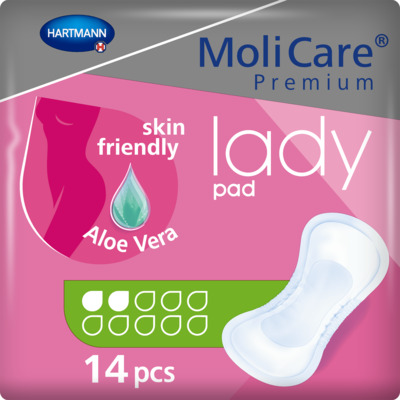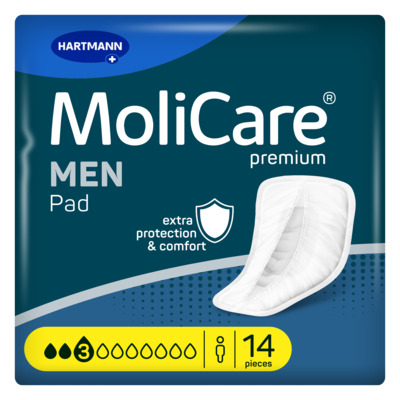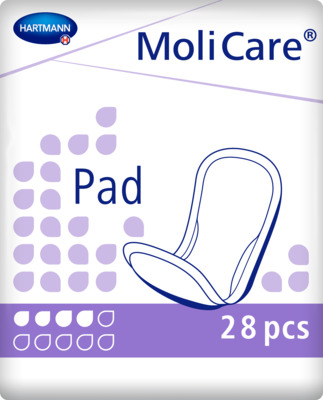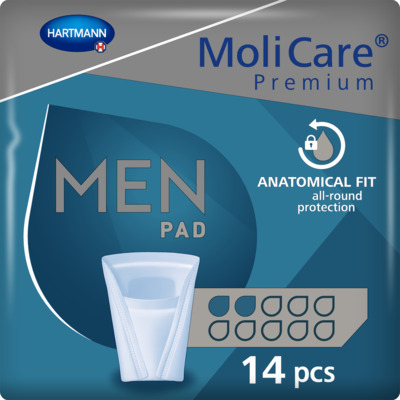Incontinence Advice
What is the difference between incontinence pads and menstrual pads?
Many women and men affected by incontinence use conventional menstrual pads to capture any urine lost. But pads specifically designed for incontinence are even more reliable and still provide discreet help with bladder weakness.

Woman buys incontinence pads
Why women and men with incontinence often use pads
It might seem to make sense to use menstrual pads instead of incontinence pads.: For many women it is already routine to buy and use panty liners. If mild bladder weakness suddenly develops, it is therefore perfectly natural to use normal panty liners for this situation as well. And men often find themselves in the situation of buying menstrual pads for their female partners. They are already familiar with this product. Camouflaged as a purchase for a female partner, men affected by incontinence also initially use menstrual pads due to shame and uncertainty about appropriate incontinence products.
Those affected often feel ashamed when urinary or faecal incontinence starts, which is why they also shy away from buying appropriate incontinence aids. The obvious solution for those affected is to buy pads. It is important to know that incontinence pads can meet your specific needs considerably better than panty liners – and you will also save money in the long term.
Read more about signs of incontinence in our new article
Why panty liners are unsuitable for incontinence
At first glance pads are more cost effective than special incontinence pads. However, they are only intended to absorb menstrual flow. Blood is thicker than urine, and escapes more slowly and in smaller volumes than urine. Conventional panty liners therefore cannot absorb the volume of urine and have to be changed a lot more frequently than incontinence pads that have a higher absorptive capacity.
Sonya Meyer, national clinical consultant at HARTMANN, explains:
‘Menstrual pads can be used with heavy periods but the pads usually only contain wood pulp and not much superabsorber. And because menstrual blood clots, it easily sticks to the fibres or the pulp of the pad. This is not the case with urine. A menstrual pad usually does not keep the skin dry and odour may also be an issue. Menstrual pads are therefore expensive because they very quickly stop being able to absorb liquid and have to be changed 10 times or more a day.’
Discover more about Causes of urinary incontinence
There are also period pads that are specifically identified as products to use with incontinence. However, they only have a low absorptive capacity - usually only able to absorb 50 to 100 millilitres and so are not comparable to products specifically designed for incontinence. This is because the special pads not only have the necessary absorptive capacity but are also geared toward the size, mobility and the sex of the person affected. The products are differentiated by their absorption capacity: from mild bladder weakness (urine loss of about 100 ml in 4 hours) to heavy urinary incontinence (about 300 ml).
Find your best product
Search Find your best productEasily order MoliCare® incontinence products online from HARTMANN
With the right incontinence pads you can work, play sport and sleep easily safe in the knowledge that you have the necessary protection. If you would like to use pads specifically developed for incontinence but would prefer not to buy them in a pharmacy near you, you can orderMoliCare® products online at any time of day or night. Depending on the severity, type and frequency of the incontinence as well as your personal preference and fit, MoliCare® from HARTMANN offers the following options:
- If you would like the products to resemble menstrual pads, we recommend the anatomically shaped pads MoliCare® Premium lady pad and MoliCare® Premium MEN Pads, which are worn in normal underwear with the help of the adhesive strip and are available with different absorbency levels.
- Along with pads there are also the anatomically shaped disposable pants MoliCare® Premium lady pants and MoliCare® Premium MEN Pants that are worn like normal underwear. These are also available in different absorbency levels and sizes.
Are you unsure which product will meet your needs? Then use our product finder and order free products to test out. Decide which products are right for you and live carefree again!
Sources:
1 Kontinenz, Inkontinenz, Kontinenzförderung, Praxishandbuch für Pflegende [Continence, incontinence, continence promotion, clinical handbook for nurses], Hayder, Kuno, Müller, Huber Verlag, page 35 ff

MoliCare® Premium Lady Pad 2 Drops
<h2>Skin Friendly Pant Liners</h2> <p>For women that experience slight incontinence and bladder weakness, across different age groups, it can be a challenge to find the right bladder weakness product that is easy to apply and wear without the worry of potential leakages. Fortunately, we understand this approach, hence why we are happy to offer our MoliCare® Premium Lady Pad 2 drops, that is skin-friendly, Aloe Vera applied, and comes with 14 liners per bag.</p> <h2>Slim and discreet liners</h2> <p>Whether dealing with stress incontinence or urge incontinence, these panty liners offer a discreet and easy solution on the go. Simply place the pad in your underwear and secure it with the adhesive strip for all-round protection. Available in different absorbency levels, MoliCare® bladder weakness products cater to all levels of bladder weakness, ensuring secure care.</p> <h2>Control Bladder Weakness</h2> <p>Enjoy the benefits of these body-shaped absorbent panty liners, designed for women with bladder weakness. The pads offer discreet, reliable protection with features including odour control and fast absorption.</p> <p>With a wide adhesive strip, you can comfortably fix the pad in your regular underwear, providing secure and comfortable fixation. The pads are skin-friendly, featuring soft, breathable materials, including foam cuffs, and a top sheet treated with Aloe Vera.</p> <p>Keeping your skin healthy is a priority, which is why MoliCare® Premium Lady Pads have a skin-neutral pH value of 5.5 and an antibacterial finish. They are also dermatologically tested, offering peace of mind.</p> <h2>Buy pant liners online</h2> <p>Never worry about running out with our convenient order service and fast delivery direct to your door. Enjoy free shipping on orders over £50.</p> <p>If you need assistance, our professional customer service team is here to support you in choosing the right product. Reach out to us today at 0800 028 9470 and experience the comfort and reliability of MoliCare® Premium Lady Pads.</p>
MoliCare® Premium Men Pad 3 Drops (ISO 441ml)
<p><strong>Reliable and discreet incontinence pads for men with an instant-dry feeling</strong></p> <p>Bladder weakness is difficult to live with, the last thing you want to worry about is incontinence protection. That’s why our best-ever MoliCare® premium MEN Pad 3 drops offer an <strong>all-round protection</strong> that keeps everything dry and comfortably in place while fitting discreetly in your regular underwear.</p> <p>The incontinence pad for men quickly <strong>removes urine from the surface up to 86 %* faster than before</strong> and neutralises unpleasant odours to leave you feeling instantly dry and in control thanks to the new <strong>MoliCare SkinGuard</strong>®<strong> Absorbent Core Technology</strong>. This skin-friendly technology not only helps you feel up to 90 %* drier than previous MoliCare® premium<strong> </strong>MEN pads, it also helps to maintain healthy skin and preventing irritation.</p> <p><strong>Engineered for the male anatomy</strong> and dermatologically tested for maximum skin compatibility, these male urinary pads do not contain colour, perfume or latex making them environmentally friendly too.</p> <p>*Compared to last generation</p>
MoliCare® Pad 4 Drops
<h2>Handy MoliCare incontinence pads to carry on the go</h2> <p>Our MoliCare® Pad 4 Drops are an essential product for those experiencing slight incontinence, allowing you to regain control and live your busy and active life without the interference of bladder weakness. Designed for both men and women, this incontinence pad for men and women offers exceptional dryness and protection, ensuring your comfort and confidence.</p> <h2>‘Barely There’ Reassurance and Reliability</h2> <p>The MoliCare® Pad 4 Drops are slimline, discreet, and adjusted to fit your body seamlessly. It fixes securely inside your underwear, providing a ‘barely there’ comfort feel. With its soft and skin-kind fabric, along with a wide adhesive fixing strip on the backsheet, you can go about your day with the assurance of being protected against leakages.</p> <p>The absorbent core effectively prevents your skin from becoming too moist, while the elastic anti-leak edging adds an extra layer of security and peace of mind. Say goodbye to any worries about odours, as the MoliCare® Pad 4 Drops also neutralises odours to keep you fresh and confident throughout the day. Don't let incontinence hold you back from living life to the fullest.</p> <p>Ordering your MoliCare® Pad 4 Drops is hassle-free, as we offer fast delivery direct to your door. With our price match promise, you can trust that you're getting the best value for your money. Plus, enjoy free delivery on all orders over £50.</p> <p>If you need assistance in finding the perfect incontinence product for your needs, our friendly customer care team is here to help. Don't hesitate to reach out to us at 0800 028 9470. Take control of your life with the reliable protection and comfort of the MoliCare® Pad, alongside other <a href="https://www.hartmanndirect.co.uk/incontinence-products/incontinence-pads" style="color:#0563c1; text-decoration:underline">incontinence pads</a>.</p>




